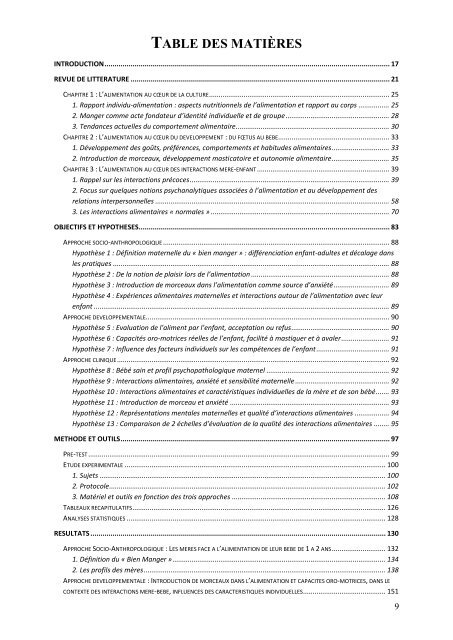La mère, son bébé et la nourriture - Université de Bourgogne
La mère, son bébé et la nourriture - Université de Bourgogne
La mère, son bébé et la nourriture - Université de Bourgogne
You also want an ePaper? Increase the reach of your titles
YUMPU automatically turns print PDFs into web optimized ePapers that Google loves.
TABLE DES MATIÈRES<br />
INTRODUCTION .............................................................................................................................................. 17<br />
REVUE DE LITTERATURE ................................................................................................................................. 21<br />
CHAPITRE 1 : L’ALIMENTATION AU CŒUR DE LA CULTURE .............................................................................................. 25<br />
1. Rapport individu-alimentation : aspects nutritionnels <strong>de</strong> l’alimentation <strong>et</strong> rapport au corps ................ 25<br />
2. Manger comme acte fondateur d’i<strong>de</strong>ntité individuelle <strong>et</strong> <strong>de</strong> groupe ...................................................... 28<br />
3. Tendances actuelles du comportement alimentaire ................................................................................ 30<br />
CHAPITRE 2 : L’ALIMENTATION AU CŒUR DU DEVELOPPEMENT : DU FŒTUS AU BEBE .......................................................... 33<br />
1. Développement <strong>de</strong>s goûts, préférences, comportements <strong>et</strong> habitu<strong>de</strong>s alimentaires .............................. 33<br />
2. Introduction <strong>de</strong> morceaux, développement masticatoire <strong>et</strong> autonomie alimentaire .............................. 35<br />
CHAPITRE 3 : L’ALIMENTATION AU CŒUR DES INTERACTIONS MERE-ENFANT ..................................................................... 39<br />
1. Rappel sur les interactions précoces ........................................................................................................ 39<br />
2. Focus sur quelques notions psychanalytiques associées à l’alimentation <strong>et</strong> au développement <strong>de</strong>s<br />
re<strong>la</strong>tions interper<strong>son</strong>nelles .......................................................................................................................... 58<br />
3. Les interactions alimentaires « normales » ............................................................................................. 70<br />
OBJECTIFS ET HYPOTHESES............................................................................................................................. 83<br />
APPROCHE SOCIO-ANTHROPOLOGIQUE ...................................................................................................................... 88<br />
Hypothèse 1 : Définition maternelle du « bien manger » : différenciation enfant-adultes <strong>et</strong> déca<strong>la</strong>ge dans<br />
les pratiques ................................................................................................................................................ 88<br />
Hypothèse 2 : De <strong>la</strong> notion <strong>de</strong> p<strong>la</strong>isir lors <strong>de</strong> l’alimentation ........................................................................ 88<br />
Hypothèse 3 : Introduction <strong>de</strong> morceaux dans l’alimentation comme source d’anxiété ............................. 89<br />
Hypothèse 4 : Expériences alimentaires maternelles <strong>et</strong> interactions autour <strong>de</strong> l’alimentation avec leur<br />
enfant .......................................................................................................................................................... 89<br />
APPROCHE DEVELOPPEMENTALE ............................................................................................................................... 90<br />
Hypothèse 5 : Evaluation <strong>de</strong> l’aliment par l’enfant, acceptation ou refus ................................................... 90<br />
Hypothèse 6 : Capacités oro-motrices réelles <strong>de</strong> l’enfant, facilité à mastiquer <strong>et</strong> à avaler ......................... 91<br />
Hypothèse 7 : Influence <strong>de</strong>s facteurs individuels sur les compétences <strong>de</strong> l’enfant ...................................... 91<br />
APPROCHE CLINIQUE .............................................................................................................................................. 92<br />
Hypothèse 8 : Bébé sain <strong>et</strong> profil psychopathologique maternel ................................................................ 92<br />
Hypothèse 9 : Interactions alimentaires, anxiété <strong>et</strong> sensibilité maternelle ................................................. 92<br />
Hypothèse 10 : Interactions alimentaires <strong>et</strong> caractéristiques individuelles <strong>de</strong> <strong>la</strong> <strong>mère</strong> <strong>et</strong> <strong>de</strong> <strong>son</strong> <strong>bébé</strong> ....... 93<br />
Hypothèse 11 : Introduction <strong>de</strong> morceau <strong>et</strong> anxiété ................................................................................... 93<br />
Hypothèse 12 : Représentations mentales maternelles <strong>et</strong> qualité d’interactions alimentaires .................. 94<br />
Hypothèse 13 : Comparai<strong>son</strong> <strong>de</strong> 2 échelles d’évaluation <strong>de</strong> <strong>la</strong> qualité <strong>de</strong>s interactions alimentaires ........ 95<br />
METHODE ET OUTILS ...................................................................................................................................... 97<br />
PRE-TEST ............................................................................................................................................................. 99<br />
ETUDE EXPERIMENTALE ........................................................................................................................................ 100<br />
1. Suj<strong>et</strong>s ..................................................................................................................................................... 100<br />
2. Protocole ................................................................................................................................................ 102<br />
3. Matériel <strong>et</strong> outils en fonction <strong>de</strong>s trois approches ................................................................................ 108<br />
TABLEAUX RECAPITULATIFS .................................................................................................................................... 126<br />
ANALYSES STATISTIQUES ....................................................................................................................................... 128<br />
RESULTATS ................................................................................................................................................... 130<br />
APPROCHE SOCIO-ANTHROPOLOGIQUE : LES MERES FACE A L’ALIMENTATION DE LEUR BEBE DE 1 A 2 ANS ............................ 132<br />
1. Définition du « Bien Manger » ............................................................................................................... 134<br />
2. Les profils <strong>de</strong>s <strong>mère</strong>s .............................................................................................................................. 138<br />
APPROCHE DEVELOPPEMENTALE : INTRODUCTION DE MORCEAUX DANS L’ALIMENTATION ET CAPACITES ORO-MOTRICES, DANS LE<br />
CONTEXTE DES INTERACTIONS MERE-BEBE, INFLUENCES DES CARACTERISTIQUES INDIVIDUELLES ........................................... 151<br />
9
















